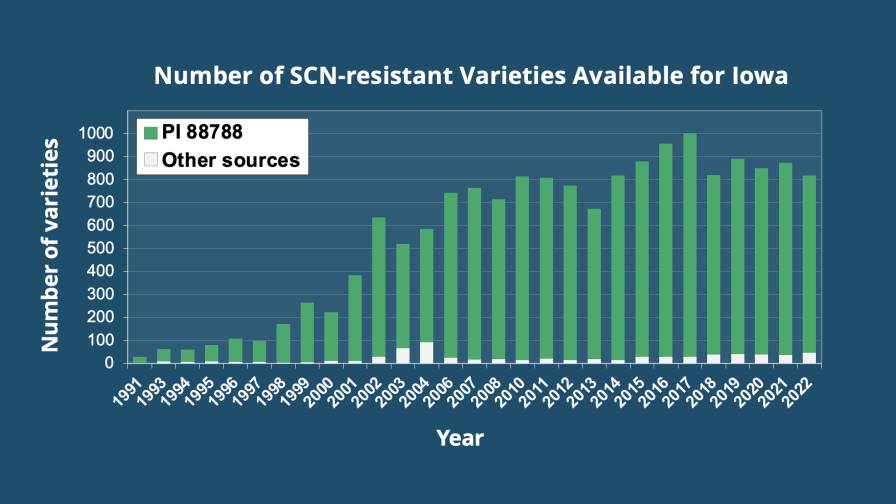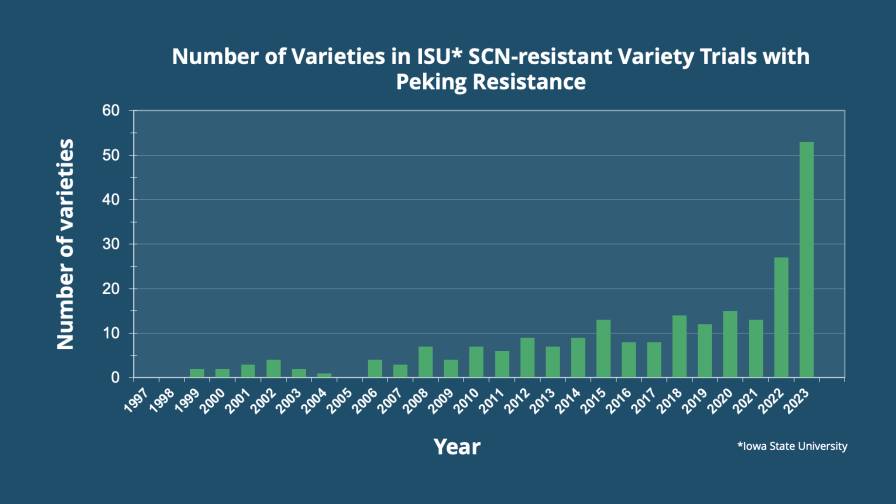Lessons Learned from Decades of Overuse of a Single Source of SCN Resistance
The farm sector is keenly aware of the dangers of dependence on a single tool, having endured the unintended consequences of narrow reliance on one herbicide active ingredient for 20-plus years. Why, then, after more than two decades does the soybean industry still lean heavily on PI 88788, a source of genetic resistance that soybean cyst nematode (SCN) populations are increasingly able to skirt? It’s complicated.
A lot has been invested into what had been a highly effective tool
Brian Diers, who recently retired from the University of Illinois and led groundbreaking research on SCN resistance, has a simple explanation for the industry’s prolonged use of PI 88788: “It’s been so darn good.” He says the successful and high-yielding germplasm has been tough to beat, despite efforts to find alternatives.
There were numerous breeding lines with SCN resistance available for variety development in the late 1980s, but none had the agronomic or maturity characteristics needed for soybean production in the Midwest, explains Greg Tylka, Iowa State University (ISU) nematologist and a leader of The SCN Coalition. Therefore, soybean breeders began crossing SCN resistance breeding lines with varieties possessing desirable agronomic characteristics.
PI 88788 stood out because it was the least difficult to work with and it outperformed other breeding lines on yield. Seed companies continually strive to create new varieties with increased yields and other improved agronomic traits. Once PI 88788 SCN resistance became available in some soybean varieties and breeding materials, these plants were used to develop additional new soybean lines and varieties. “It’s most efficient to take what’s already good in the breeding program with PI 88788 SCN resistance and improve on it,” adds Tylka. “That’s a main reason why 95% of SCN-resistant soybeans on the market today rely on PI 88788.”

PI 88788-based SCN-resistant soybean varieties (shown in white in graph above) still dominate the market in Iowa and other states.
Continuous use of a single resistance source is not the answer
Varieties with SCN resistance from PI 88788 allowed farmers to produce soybeans profitably in SCN-infested fields for decades. PI 88788 was slow acting on the nematode and “leaky,” meaning there were low levels (< 10%) of SCN reproduction on varieties with this SCN resistance from the beginning, says Tylka. But the ability of SCN populations to reproduce on PI 88788 slowly increased as time passed, snowballing to the point that many farmers now face a major resistance problem.
The second-most common source of SCN resistance, Peking, is fast acting and highly effective. But in many cases, the stronger the chemical or pest resistance, the quicker the targeted pest population will overcome it. “Very few nematodes are able to overcome Peking resistance,” Tylka explains. “But those that do have a high likelihood of passing that ability along to their offspring. With Peking SCN resistance, the very few nematodes that successfully reproduce will likely become a high percentage of SCN populations in fewer years than we saw with PI 88788.”
The slow but dramatic buildup of SCN reproduction on soybean varieties with PI 88788 resistance has resulted in varieties with Peking SCN resistance that now outyield those by 20 bushels an acre or more, according to a 2019 study by Tylka. Therefore, he’s concerned farmers may be tempted to plant Peking year after year. Doing so might generate more income in the short term but could result in greater yield reductions in the long term.
Therefore, Tylka urges farmers to:
- Start growing varieties with Peking SCN resistance NOW.
- Never grow varieties with Peking SCN resistance in consecutive soybean crops.
- Alternate growing Peking SCN-resistant varieties with varieties containing PI 88788 resistance.
- Plant non-host crops, such as corn, in annual rotation with soybeans.
Peking availability far from universal
Farmers outside the primary soybean-producing states may not have a Peking option for their maturity zone, handicapping their long-term defense against SCN. North Dakota farmer Chandra Langseth says farmers in her state are frustrated by a lack of seed options for proactive management of SCN.
Langseth says while SCN-resistant variety options for North Dakota have improved, they are still primarily based on PI 88788, which means “we may be shooting ourselves in the foot by planting the same resistance source year after year.”
Overcoming that obstacle will require “a major shift in soybean breeding efforts and increased and sustained funding for basic and applied research,” says Tylka.
Signs of progress
Tylka was encouraged to see the number of varieties with Peking SCN resistance double to 53 for his 2023 SCN-resistant soybean variety trials for maturity groups 1, 2 and 3. “While PI 88788 remains the dominant resistance source in SCN-resistant soybean varieties available to farmers, the increase in Peking offerings for these maturity groups shows seed companies are increasingly aware of the problem and working to fight SCN – now and in the future.”

The number of Peking varieties in ISU’s SCN-resistant soybean variety trials doubled from 2022 to 2023, indicating more soybean farmers in the upper soybean belt will be able to grow soybean varieties with this alternative source of SCN resistance in upcoming seasons.





